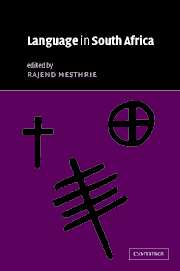Book contents
- Frontmatter
- Contents
- List of maps
- List of contributors
- Acknowledgements
- List of phonetic symbols
- List of abbreviations
- Introduction
- Part I The main language groupings
- 1 South Africa: a sociolinguistic overview
- 2 The Khoesan Languages
- 3 The Bantu languages: sociohistorical perspectives
- 4 Afrikaans: considering origins
- 5 South African English
- 6 South African Sign Language: one language or many?
- 7 German speakers in South Africa
- 8 Language change, survival, decline: Indian languages in South Africa
- Part II Language contact
- Part III Language planning, policy and education
- Index
- References
6 - South African Sign Language: one language or many?
from Part I - The main language groupings
Published online by Cambridge University Press: 22 September 2009
- Frontmatter
- Contents
- List of maps
- List of contributors
- Acknowledgements
- List of phonetic symbols
- List of abbreviations
- Introduction
- Part I The main language groupings
- 1 South Africa: a sociolinguistic overview
- 2 The Khoesan Languages
- 3 The Bantu languages: sociohistorical perspectives
- 4 Afrikaans: considering origins
- 5 South African English
- 6 South African Sign Language: one language or many?
- 7 German speakers in South Africa
- 8 Language change, survival, decline: Indian languages in South Africa
- Part II Language contact
- Part III Language planning, policy and education
- Index
- References
Summary
INTRODUCTION
In this chapter we discuss the signed language used by the Deaf community in South Africa, and examine the historical conditions for its emergence. We describe the legal and actual situation of South African Sign Language in South Africa today, particularly in relation to schooling. We investigate the different factors that underlie the claims that there is more than one sign language in South Africa, and we spell out the practical consequences of accepting these claims without further examination.
We assume without argument that Deaf people in South Africa, far from being deficient, or disabled, are a linguistic minority, with their own language, South African Sign Language, and their own culture, South African Deaf culture. Like everyone else in this post-modern world, Deaf people have differential membership in many cultures, on the basis of, for instance, religion, lifestyle, daily practices, political beliefs and education. However, what they all have in common is membership in a community that uses signed language, and socialises with other people who do the same.
Thus, the model we adopt is non-medical. We are not interested here in degree of hearing loss, the remediation of hearing, audiological measures, speech therapy or any other medical views of deafness. We regard deafness only as the sufficient, but not necessary, precipitant of signed-language development, and our concern here is to examine certain sociolinguistic issues that come into play in the consideration of the status of the signed language used in South Africa.
- Type
- Chapter
- Information
- Language in South Africa , pp. 127 - 147Publisher: Cambridge University PressPrint publication year: 2002
References
- 12
- Cited by



